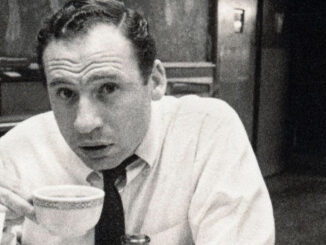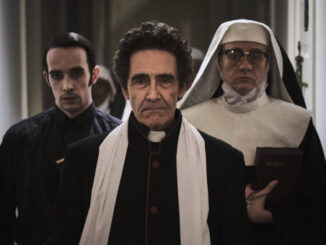 (Director Junta Yamaguchi’s Beyond The Infinite Two Minutes screened earlier this week at the Philadelphia Film Festival and is still available to watch on the Festival’s Virtual Cinema.)
(Director Junta Yamaguchi’s Beyond The Infinite Two Minutes screened earlier this week at the Philadelphia Film Festival and is still available to watch on the Festival’s Virtual Cinema.)
Director Junta Yamaguchi’s delightfully twisty Beyond The Infinite Two Minutes is a playful and smart take on the time loop science-fiction trope. Thanks to its low budget roots, it displays more ingenuity in its script as opposed to relying on costly spectacle, and the audience is so much the better for it.
One evening, after closing his small cafe for the day, Kato makes an unbelievable discovery. The television screen in his apartment above his business is somehow connected to a similar screen downstairs. But weirdly enough, they are connected through time, with the television in his apartment communicating with the television in the cafe two minutes in the future. By running up and down the stairs between the shop and his apartment, Kato discovers that he can have conversations with himself. And when some friends arrive, they soon start to think of ways that they can use these glimpses into the near future and how to expand their reach more past the two minutes limit. Kato is wary of how everyone is using their new found ability to communicate with the near future, and he is proven right when a glimpse of a dangerous man threatening one of the group with a knife is seen.
Yagamuchi’s script quickly and simply establishes its rules for how his particular time loop works. But rather than just set the boundaries for the story Yagamuchi makes much of the story be his characters testing those boundaries, questioning them and trying to stretch them. It is what I would like to think me and my friends would do in a similar situation were it to happen to us. All of this serves to build towards the third act, when Kato and his friends run afoul of the knife-wielding ne’er-do-wells. The whole film is an intricately build structure and it is a joy to watch it all come together.
The key to the how the film works lies in Yagamuchi’s decision to film the whole thing as one continual shot. They way we stay with first Kato and then the others as they discover and explore the possibilities of the time loop that they’ve discovered helps to immerse us in the premise. And that is to the film’s benefit once the third act kicks in and the tone shifts as they face off against the two criminals they inadvertently ensnare in their timeloop shenanigans. As Kato marches upstairs towards his confrontation with them, the tension can’t help but mount. An experienced eye can probably guess where he digitally stitched individual shots together, but that does not take away from the enjoyment of the film in the least.
The cast of actors that Yagamuchi has gathered deserve some special mention for the work they have to do here. Granted, replicating a performance through multiple takes is something that actors have to do during film production anyway, but here they are playing both sides of conversations with themselves twice, once for the part that appears on the screen and once while they are on the other side of the time distortion.
As to why this is all happening, Yagamuchi gets towards that at the end of the film, though that plot point and its resolution almost seem to be an afterthought after all that has come before. Normally the mechanics of such things are something I gravitate towards, but in this instance the energy that Yagamuchi and his cast brought to the film pushed that concern right out.





